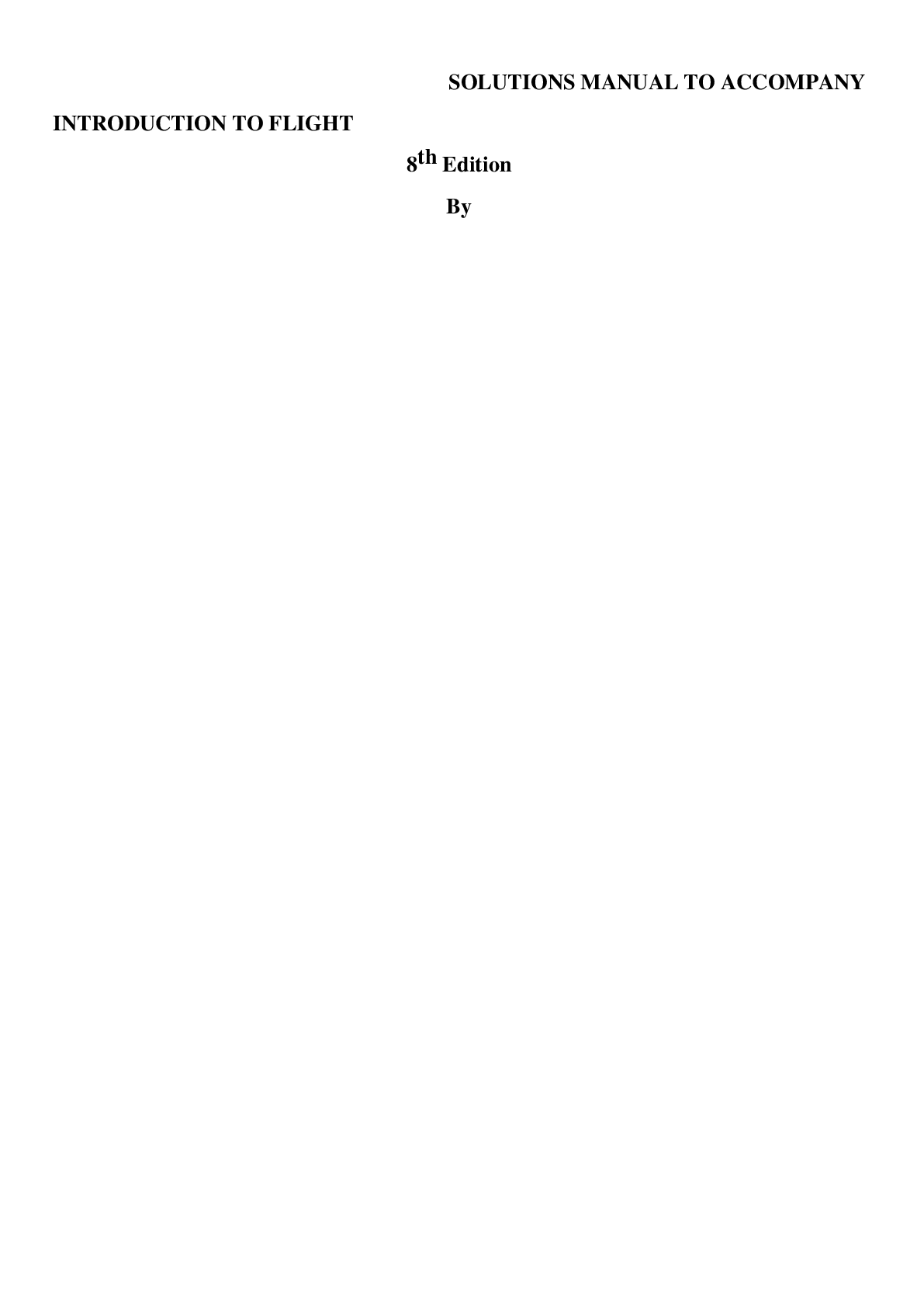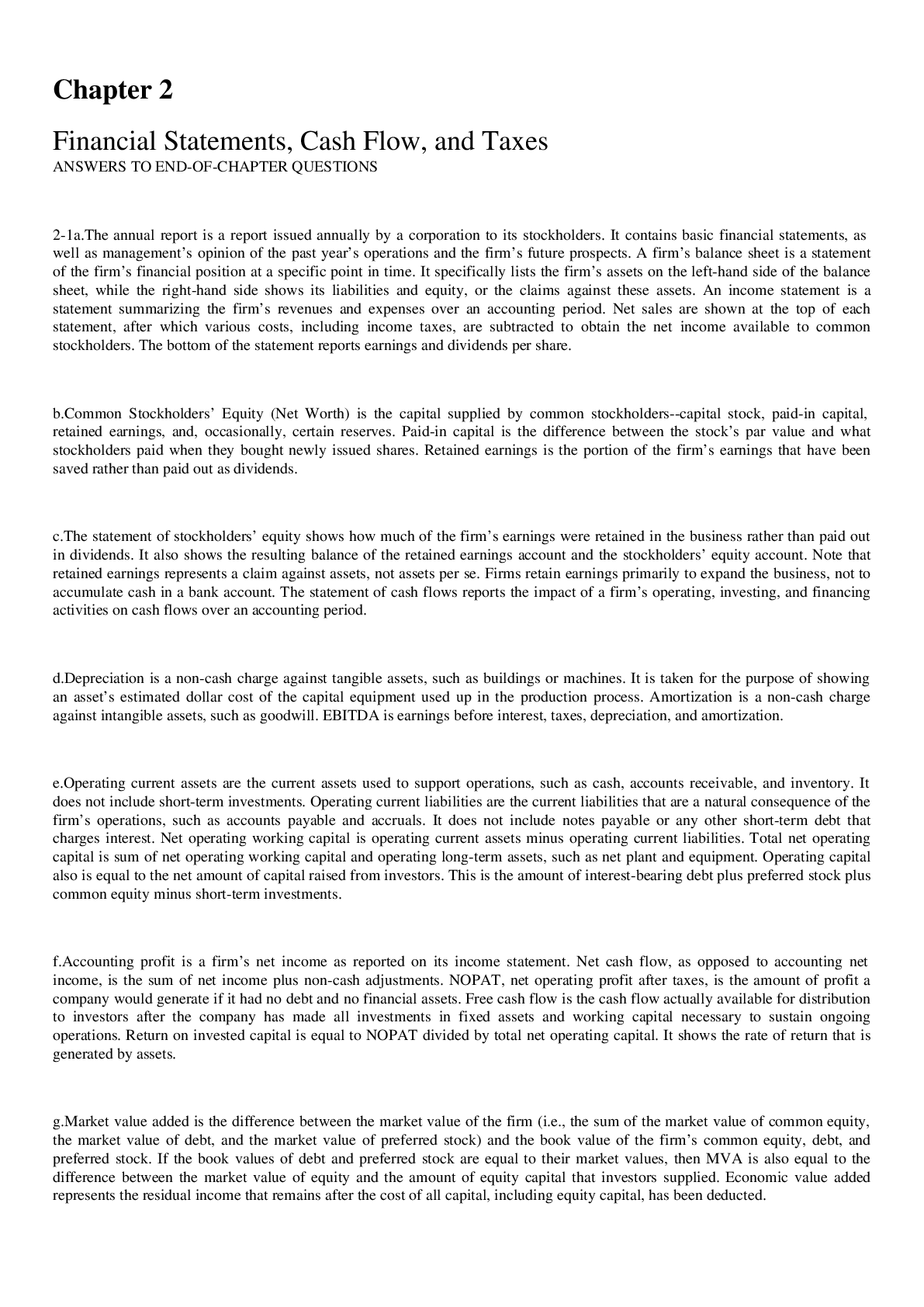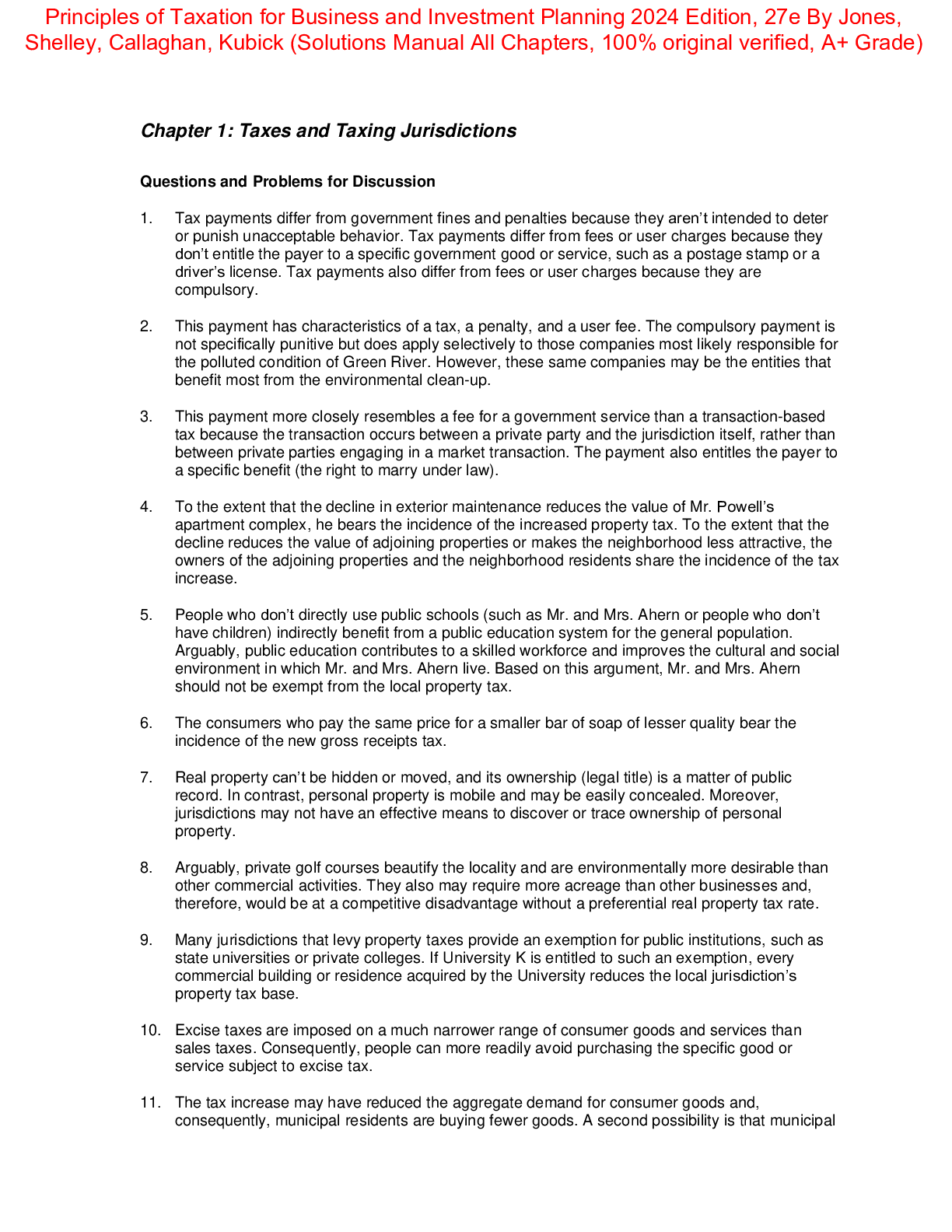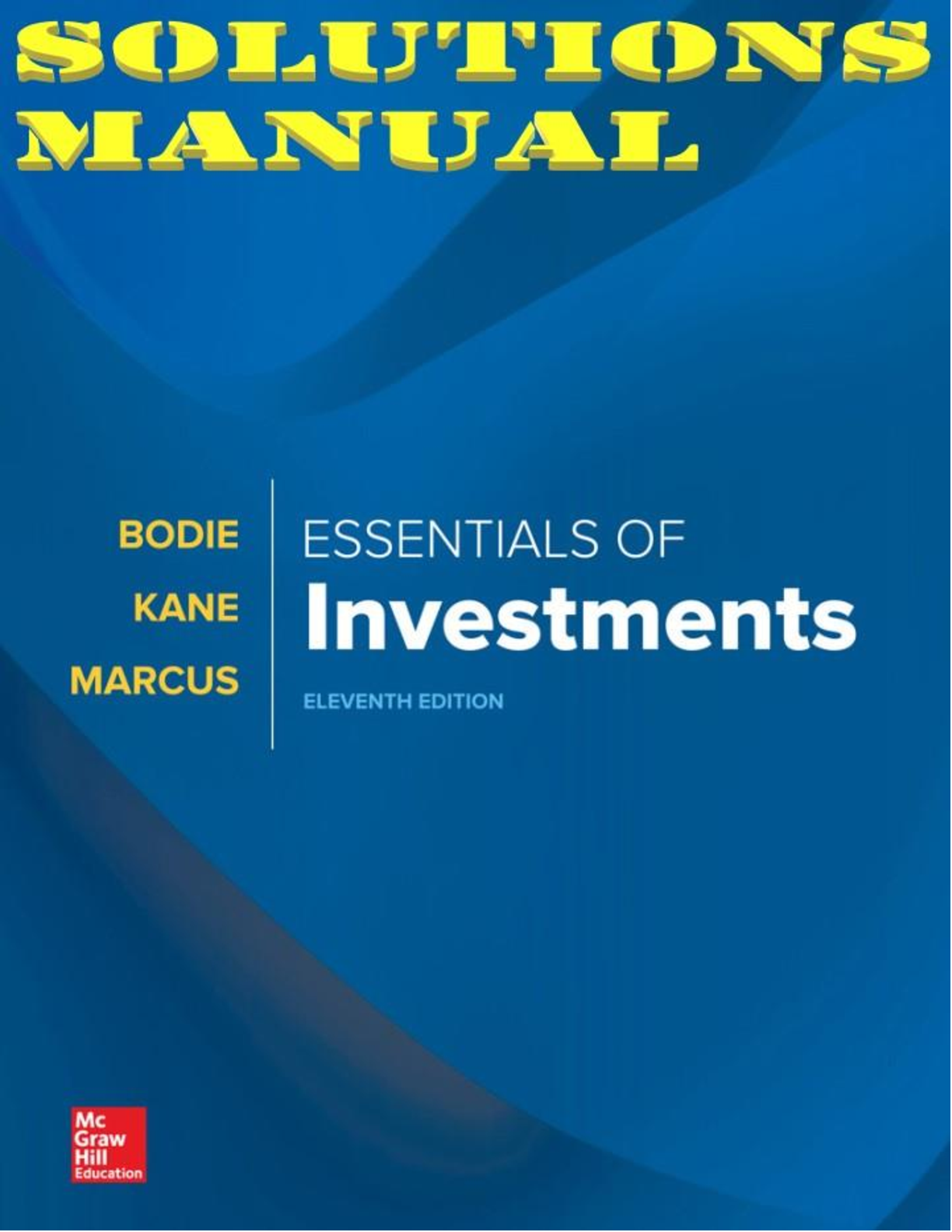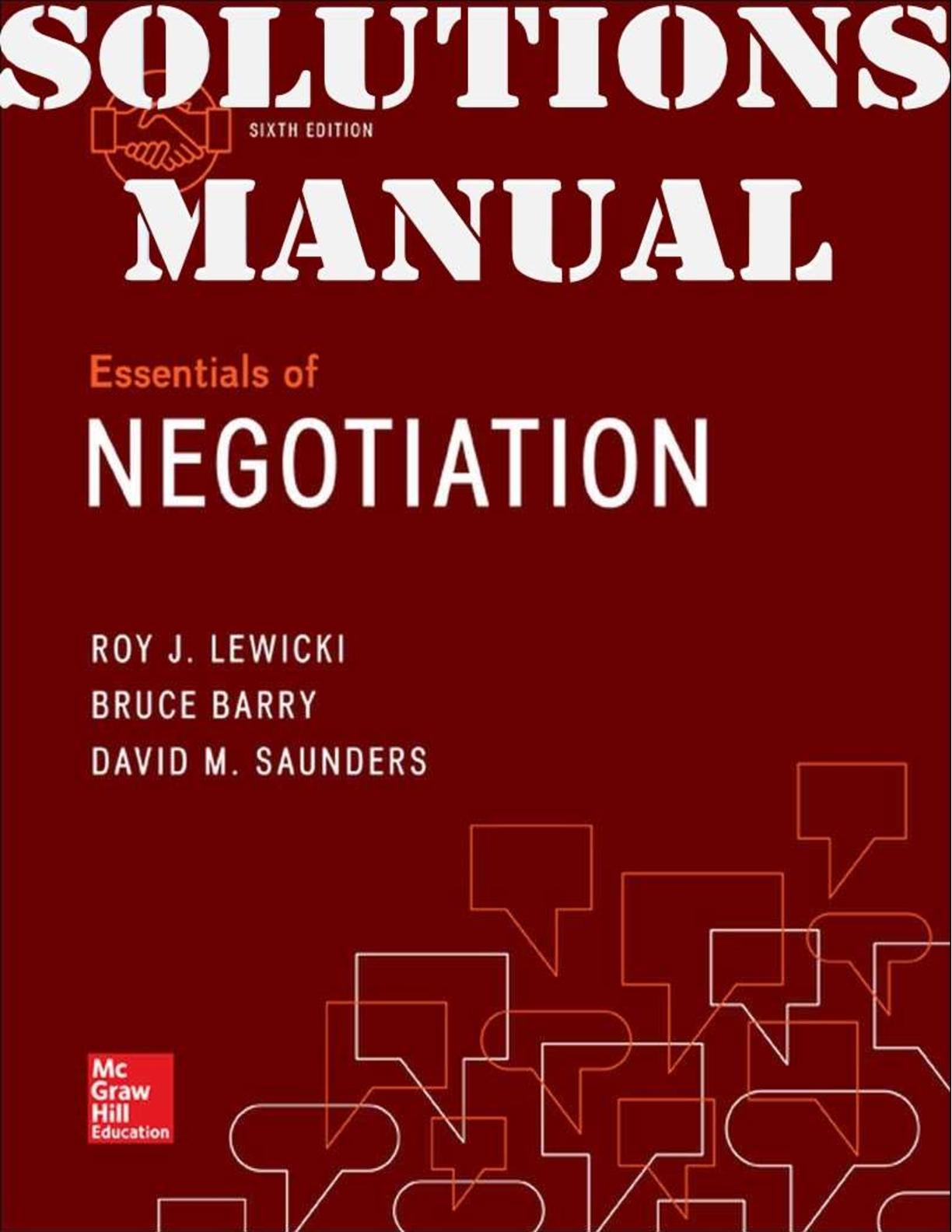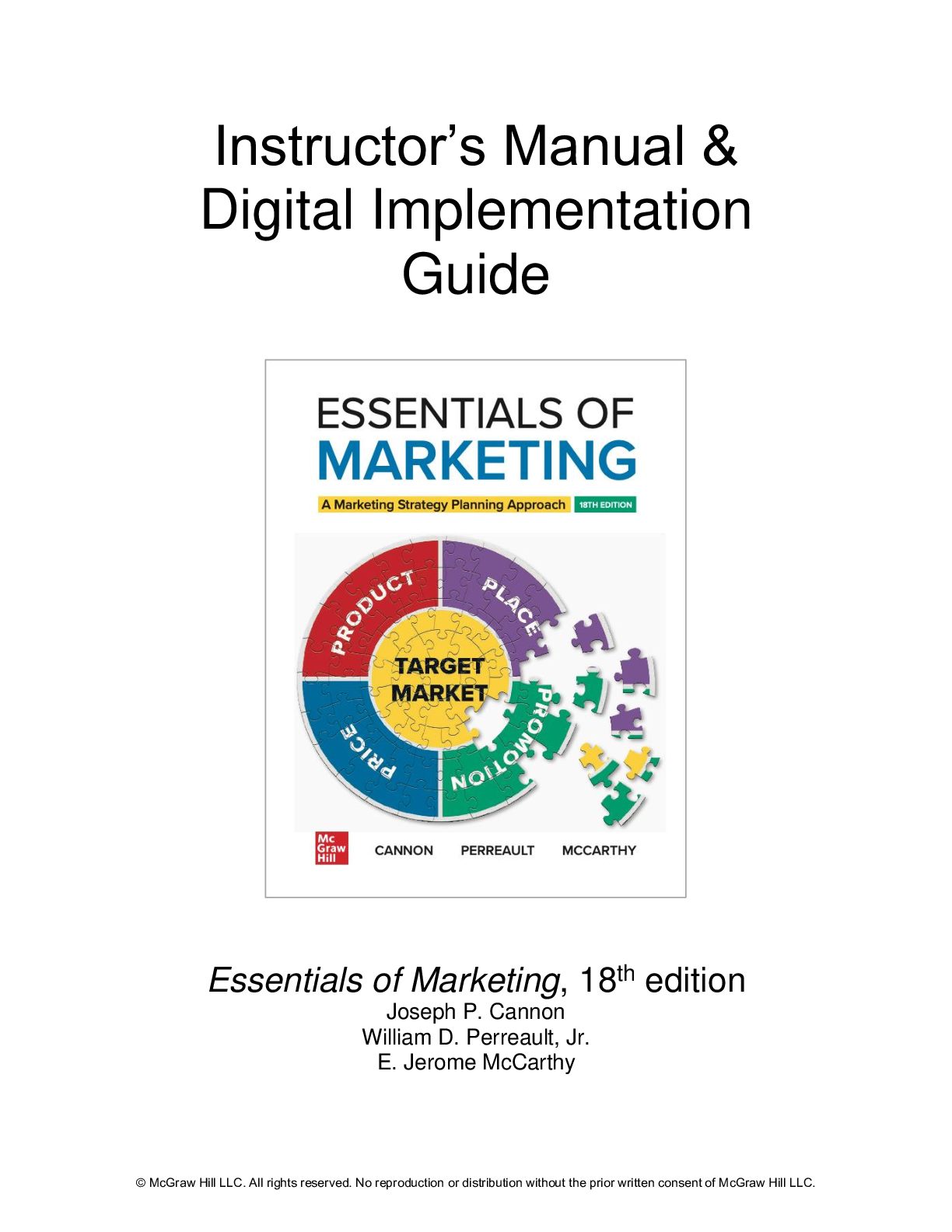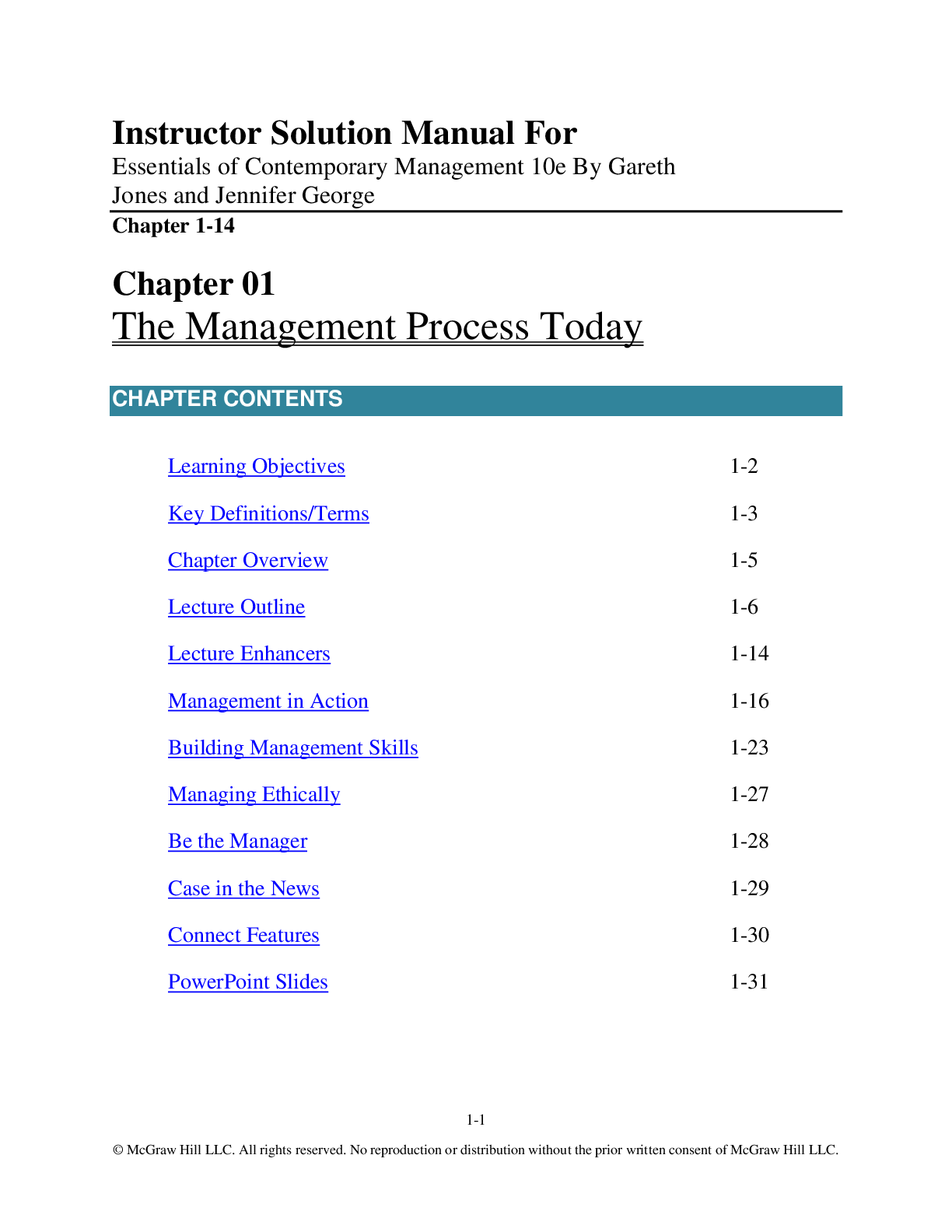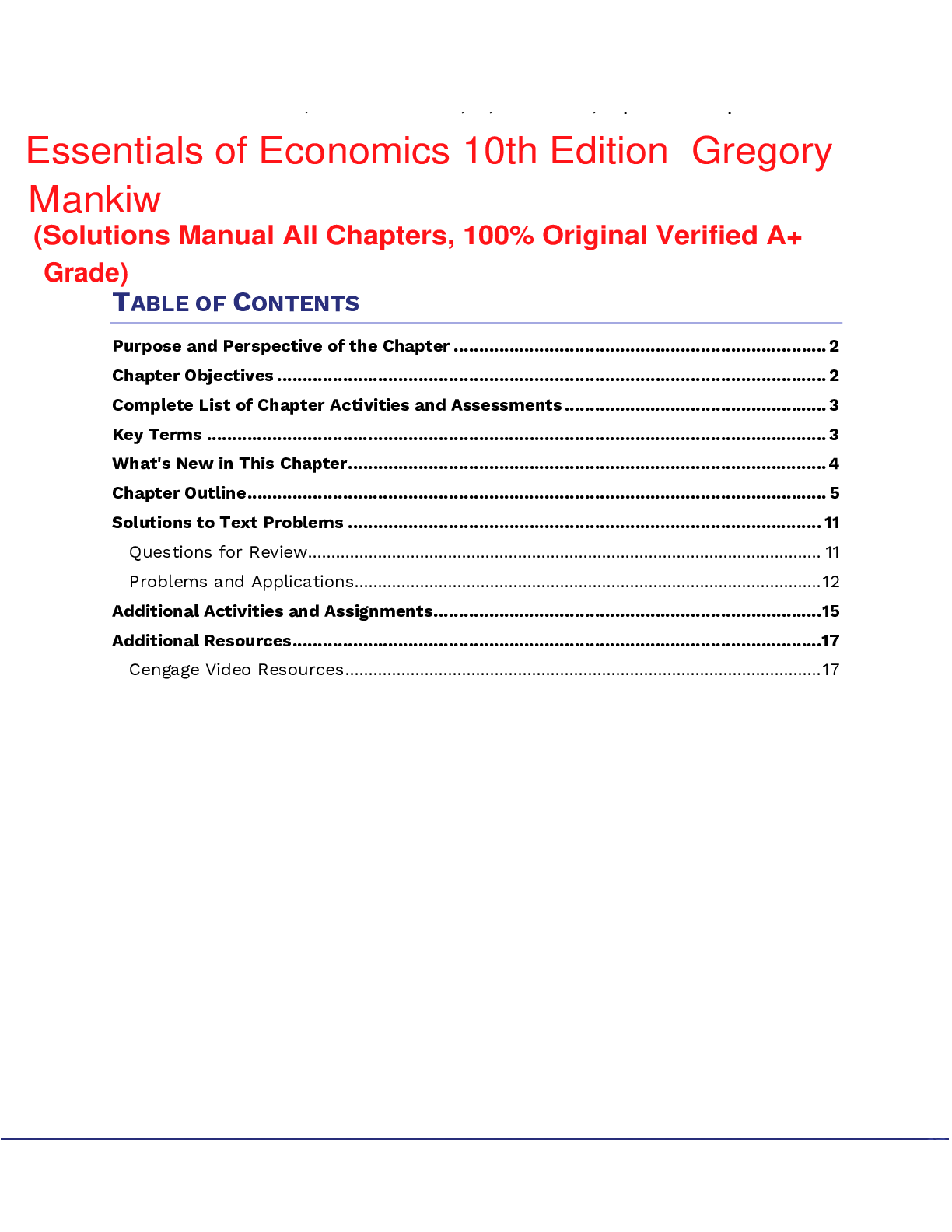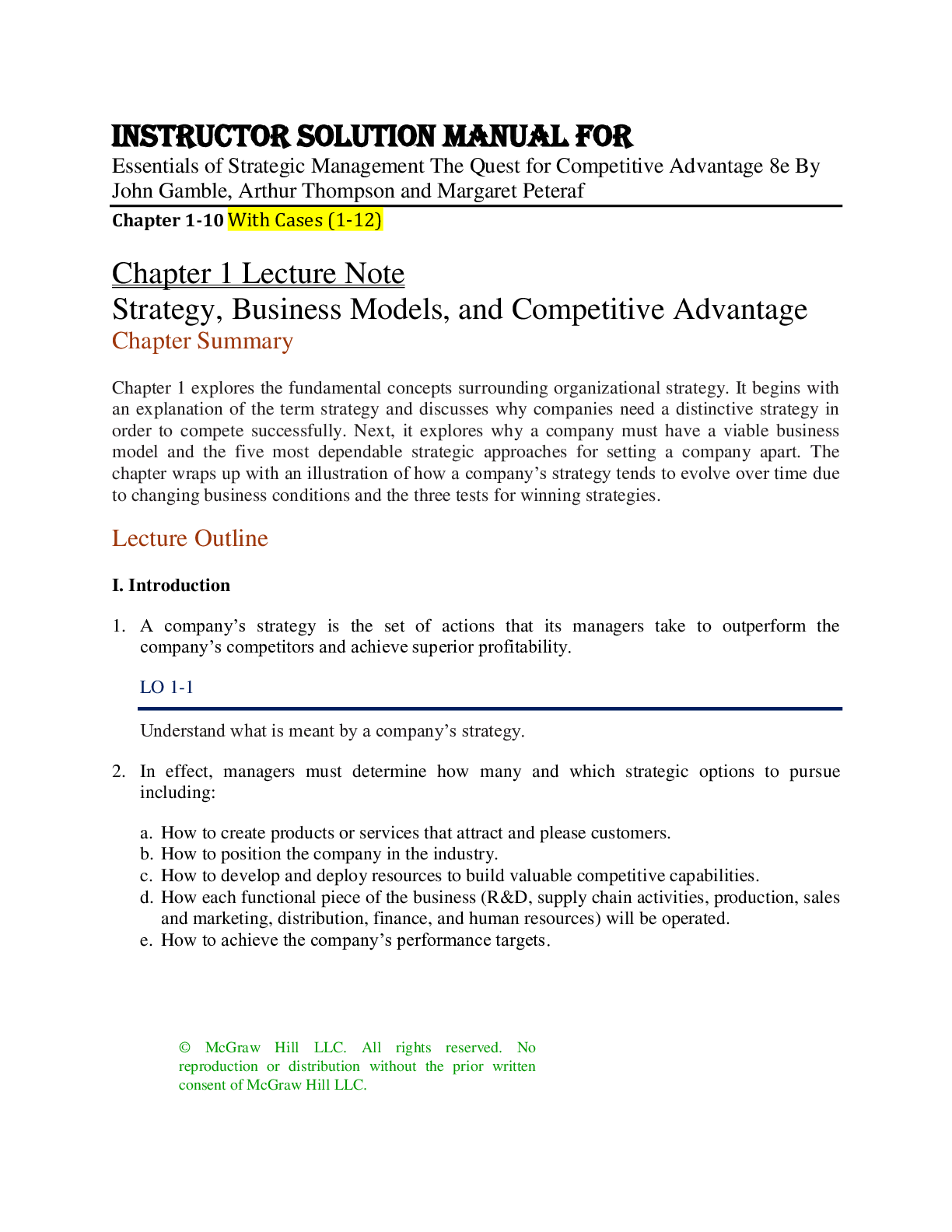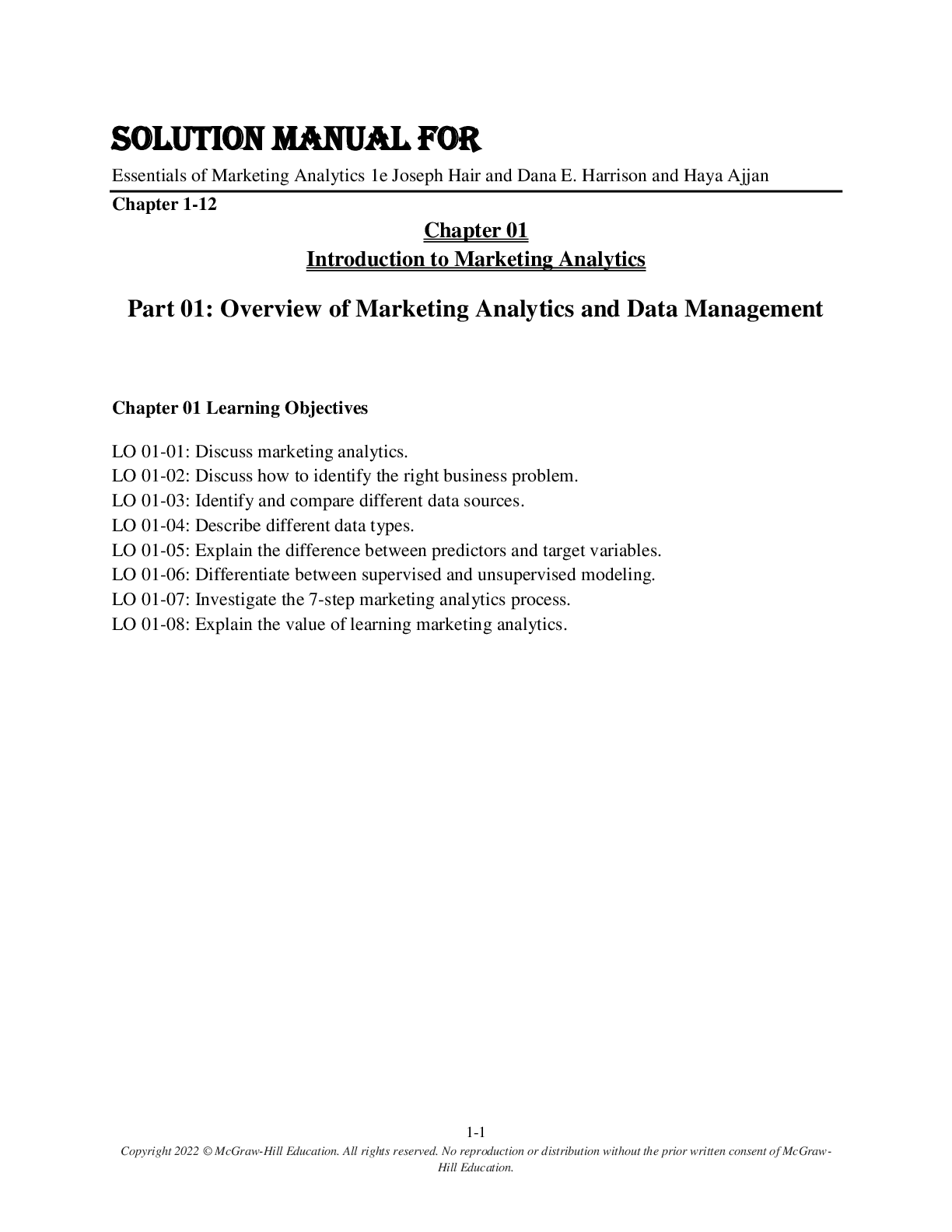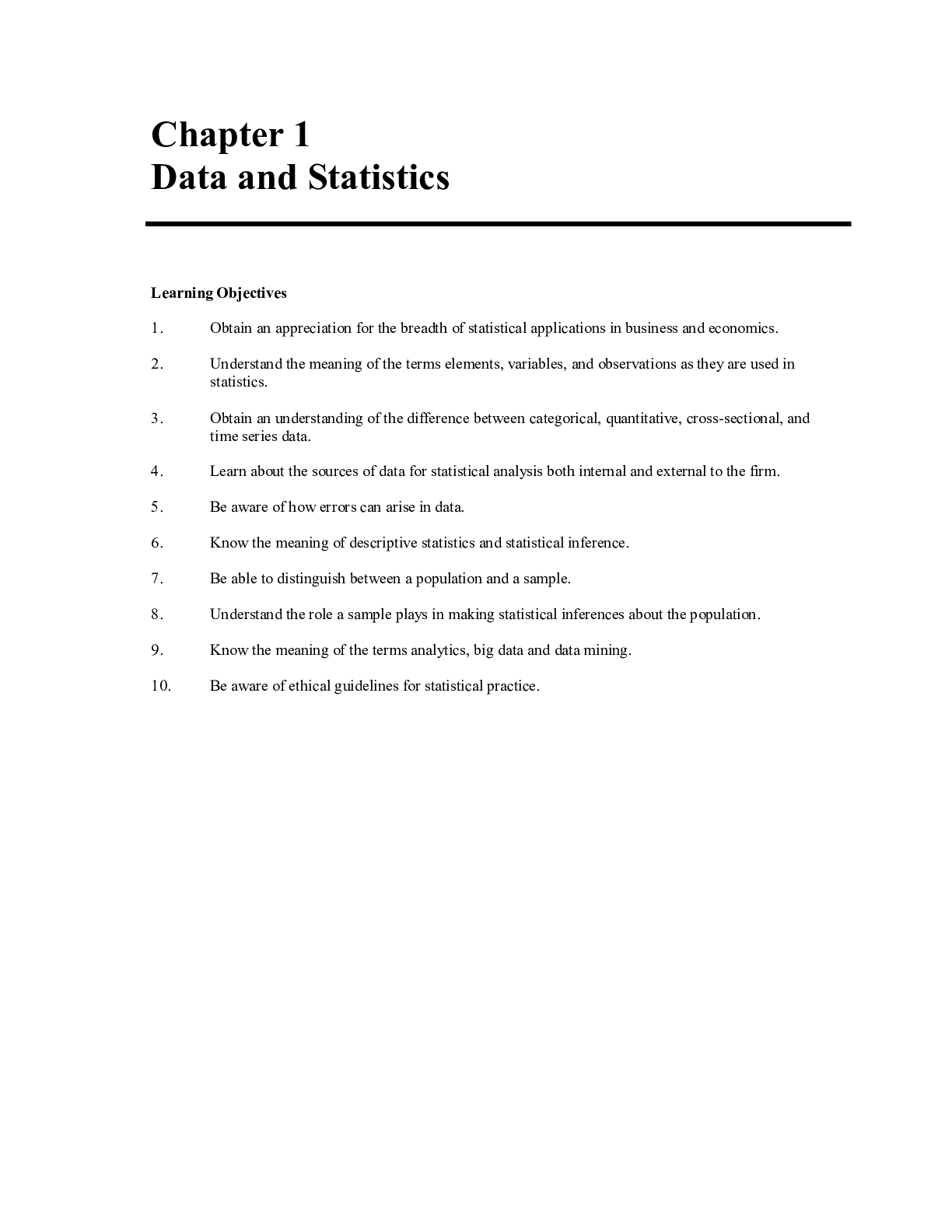Business Administration > SOLUTIONS MANUAL > Solution Manual For Essentials of Contemporary Management 8th Edition by Jones, George (All)
Solution Manual For Essentials of Contemporary Management 8th Edition by Jones, George
Document Content and Description Below
Chapter 02 Values, Attitudes, Emotions, and Culture: The Manager as a Person Learning Objectives 2-2 Key Definitions/Terms 2-2 Chapter Overview 2-3 Lecture Outline 2-4 Lecture Enhanc... ers 2-11 Management in Action 2-13 Building Management Skills 2-15 Managing Ethically 2-16 Small Group Breakout Exercise 2-16 Be the Manager 2-17 Case in the News 2-18 Connect Features 2-19 Manager’s Hot Seat 2-19 Self-Assessment(s) 2-19 In-Class Activities 2-19 LO 2-1. Describe the various personality traits that affect how managers think, feel, and behave. LO 2-2. Explain what values and attitudes are, and describe their impact on managerial action. LO 2-3. Appreciate how moods and emotions influence all members of an organization. LO 2-4. Describe the nature of emotional intelligence and its role in management. LO 2-5. Define organizational culture, and explain how mangers both create and are influenced by organizational culture agreeableness: The tendency to get along well with other people attitude: A collection of feelings and beliefs attraction-selection-attrition (ASA) framework: A model that explains how personality may influence organizational culture conscientiousness: The tendency to be careful, scrupulous, and persevering emotional intelligence: The ability to understand and manage one’s own moods and emotions and the moods and emotions of other people emotions: Intense, relatively short-lived feelings external locus of control: The tendency to locate responsibility for one’s fate in outside forces and to believe that one’s own behavior has little impact on outcomes extraversion: The tendency to experience positive emotions and moods and to feel good about oneself and the rest of the world instrumental value: A mode of conduct that an individual seeks to follow internal locus of control: The tendency to locate responsibility for one’s fate within oneself job satisfaction: The collection of feelings and beliefs that managers have about their current jobs mood: A feeling or state of mind need for achievement: The extent to which an individual has a strong desire to perform challenging tasks well and to meet personal standards for excellence need for affiliation: The extent to which an individual is concerned about establishing and maintaining good interpersonal relations, being liked, and having other people get along need for power: The extent to which an individual desires to control or influence others negative affectivity: The tendency to experience negative emotions and moods, to feel distressed, and to be critical of oneself and others norms: Unwritten, informal codes of conduct that prescribe how people should act in particular situations and are considered important by most members of a group or organization openness to experience: The tendency to be original, have broad interests, be open to a wide range of stimuli, be daring, and take risks organizational citizenship behaviors (OCBs): Behaviors that are not required of organizational members but that contribute to and are necessary for organizational efficiency, effectiveness, and competitive advantage organizational commitment: The collection of feelings and beliefs that managers have about their organization as a whole organizational culture: The shared set of beliefs, expectations, values, norms, and work routines that influence how individuals, groups, and teams interact with one another and cooperate to achieve organizational goals organizational socialization: The process by which newcomers learn an organization’s values and norms and acquire the work behaviors necessary to perform jobs effectively personality traits: Enduring tendencies to feel, think, and act in certain ways self-esteem: The degree to which individuals feel good about themselves and their capabilities terminal value: A lifelong goal or objective that an individual seeks to achieve value system: The terminal and instrumental values that are guiding principles in an individual’s life This chapter focuses upon the manager as a feeling, thinking human being. We start by describing enduring personality characteristics that influence how managers ‘manage,” as well as how they view other people, their organizations, and the world around them. We discuss as well how managers’ values, attitudes, and moods play out in organizations, shaping organizational culture. This chapter provides a strong appreciation of how the personal characteristics of managers influence the process of management in general, and organizational culture in particular. NOTE ABOUT POWERPOINT SLIDES A separate file contains Instructor PowerPoint Slides include most Student PowerPoint slides, along with additional material that can be used to expand the lecture. Management Snapshot Kevin Plank’s Determination and Openness to Experience at Under Armour When Kevin Plank was a football player at the University of Maryland in the 1990s, he often became annoyed that his T-shirt was soaked and weighted down with sweat. He wondered why athletic apparel couldn’t be made out of some kind of polyester blend that would help athletes’ and sports aficionados’ muscles stay cool while wicking away moisture. Soon he started experimenting with different fabrics, testing their durability, comfort, and water resistance. Before long, a prototype of Under Armour’s first product was developed. (p.48) Entering and succeeding in the competitive sports apparel industry dominated by huge players, such as Nike, seemed like an impossible feat. With around $20,000 in the bank and the resolve to turn his idea into a viable venture, Plank succeeded against all odds. Plank used his network of athletic contacts from playing on teams in high school, military school, and the University of Maryland to get the word out about the shirt. As business and orders picked up, Under Armour outgrew its basement office and set up shop on Sharp Street in Baltimore. Under Armour is currently headquartered in a 400,000-squarefoot complex. It is a global company that produces athletic apparel and accessories for women, men, and youth. Clearly Plank demonstrates that being original, daring, and taking risks while at the same time being highly determined, disciplined, and persevering can help managers and entrepreneurs succeed against tough odds. I. Enduring Characteristics: Personality Traits Personality traits are enduring tendencies to feel, think, and act in certain ways. It is important to understand the personalities of managers because their personalities influence their behavior and their approach to managing people and resources. A. The Big Five Personality Traits The Big Five is a group of five general traits that contribute to the composition of an individual’s personality. Each should be evaluated along a continuum. 1. Extraversion is the tendency to experience positive emotions and moods and feel good about oneself and the rest of the world. Being high on this trait can be an asset for managers whose jobs entail an especially high level of social interaction. Those low on this factor can be highly effective if excessive social interaction is not required by their job. 2. Negative Affectivity is the tendency to experience negative emotions and moods, feel distressed, and be critical of others. Managers high on this trait may often feel angry and dissatisfied and complain about their own and others’ lack of progress. Those who are low on negative affectivity do not tend to experience many negative emotions and are less pessimistic and critical of themselves and others. 3. Agreeableness is the tendency to get along well with others. Managers high on this continuum are likeable, tend to be affectionate, and care about other people. Those who are low may be somewhat distrustful of others, unsympathetic, uncooperative, and even at times antagonistic. See Figure 2.2 for a measure of this. 4. Conscientiousness is the tendency to be careful, scrupulous, and persevering. Managers who are high on this factor are organized and self-disciplined while those who are low may seem to lack self-direction and self-discipline. 5. Openness to experience is the tendency to be original, have broad interests, be open to a wide range of stimuli, be daring, and take risks. Those high on this trait continuum like to take risks and sometimes choose to become an entrepreneur, while those low on this scale tend to be more conservative in their planning and decision-making. B. Other Personality Traits that Affect Managerial Behavior 1. The locus of control trait captures an individual’s beliefs concerning the amount of control they have over what happens to and around them. a. People with an internal locus of control believe that they are responsible for their own fate and see their own actions and behaviors as being important and decisive determinants of future outcomes. b. People with an external locus of control believe that outside forces are responsible for what happens to and around them and that their own actions don’t make much of a difference. 2. Self-esteem is the degree to which individuals feel good about themselves and their capabilities. 3. Needs for achievement, affiliation and power have been extensively researched by psychologist David McClelland. a. The need for achievement is the extent to which an individual has a strong desire to perform challenging tasks well and to meet personal standards for excellence. b. The need for affiliation is the extent to which an individual is concerned about establishing and maintaining good interpersonal relations, being liked and getting along with other people. c. The need for power is the extent to which an individual desires to control or influence others. II. Values, Attitudes, and Moods and Emotions A. Values: Terminal and Instrumental 1.A terminal value is a personal conviction about lifelong goals or objectives while an instrumental value is a personal conviction about desired modes of conduct or ways of behaving. 2. Terminal values often lead to the formation of norms, which are informal rules of conduct for behaviors considered to be important within an organization. 3. A leading researcher identified 18 terminal values and 18 instrumental values that when placed in rank order, will describe a person’s value system. B. Attitudes An attitude is a collection of feelings and beliefs. A manager’s attitude affects how they approach their job. Two of the most important attitudes in this context are: 1. Job Satisfaction is the collection of feelings and beliefs that managers have about their current job. See Figure 2.3 for a sample of items from two measures of job satisfaction. a. Managers who are satisfied with their jobs are more likely to perform organizational citizenship behaviors (OCBs). OCBs are behaviors that are not required but contribute to organizational efficiency, effectiveness, and gaining a competitive advantage. b. A growing source of dissatisfaction for many lower- and middle-level managers and employees is the threat of unemployment and increased workloads from downsizing. c. The ways in which layoffs are handled is important for both layoff victims and survivors. 2. Organizational commitment is the collection of feelings and beliefs that managers have about their organization as a whole. With organizational commitment, managers: a. Believe in what their organizations are doing b. Are proud of what the organization stands for c. Feel a high degree of loyalty toward their organizations. C. Moods and Emotions 1. Mood: A mood is a feeling or state of mind. Personality traits and current circumstances often determine a person’s mood. See Figure 2.4 for a measure of positive and negative mood at work 2. Emotions: Emotions are more intense than moods, are more short-lived, and are usually linked to a specific cause. III. Emotional Intelligence (EI) Emotional Intelligence is the ability to understand and manage one’s own moods and emotions, as well as the moods and emotions of others. 1. Managers with high levels of EI are able to prevent their emotions from getting in the way of making effective decisions. 2. EI helps managers perform the interpersonal roles of figurehead, leader, and liaison. 3. Emotional intelligence helps managers understand and relate well to other people. IV. Organizational Culture Organizational culture describes the set of beliefs, expectations, values, norms, and work routines that influence how members of an organization relate to one another and work together to achieve organizational goals. 1. When members share an intense commitment to goals, a strong organizational culture exists. When the opposite is true, the organization’s culture is weak 2. When an organization’s culture is very strong, it is often referred to as the organization’s ‘personality’ because it influences the way its members behave. A. Managers and Organizational Culture 1. Managers play a particularly important part in influencing organizational culture. This is most evident in the start-up of new companies 2. Management researcher Benjamin Schneider developed a model called the attraction-selection-attrition (ASA) framework, which posits that entrepreneurs tend to hire employees whose personalities are similar to their own. B. The Role of Values and Norms in Organizational Culture Shared values, as well as shared norms, play a particularly important role in organizational culture. Terminal values signify what an organization and its employees are trying to accomplish, and instrumental values guide how the organization and its members achieve organizational goals. 1. Values of the founder: From the ASA model previously discussed, it is clear that founders can have a profound and long-lasting effect on organizational culture. 2. Organizational Socialization: This is the process by which newcomers learn an organization’s values and norms and acquire the work behaviors necessary to perform jobs effectively. As a result, organizational values and norms are internalized. 3. Ceremonies and rites: These are formal events that recognize incidents of importance to the organization as a whole and to specific employees. The most common rites that organizations use to transmit cultural norms and values to their members are rites of passage, of integration, and of enhancement. (See Table 2.1 for examples of the rites listed below.) a. Rites of passage determine how individuals enter, advance within, or leave an organization. b. Rites of integration build and reinforce common bonds among organizational member c. Rites of enhancement let organizations publicly recognize and reward employee contributions and thus strengthen their commitment to organizational values. 4. Stories and language: Stories frequently told within an organization, either fact or fiction, provide important clues about values and norms. The slang or jargon that people within an organization use to frame and describe events also provides important clues about norms and values. C. Culture and Managerial Action Culture influences the way in which managers perform their four main functions. 1. Planning: In an innovative organizational culture, top managers are likely to develop a flexible approach to planning and to encourage participation by subordinates. In contrast, managers in a conservative organizational culture are likely to emphasize top-down planning. 2. Organizing: Because they value creativity, managers in an innovative culture are likely to create an organic structure that is flat and in which authority is decentralized. In contrast, managers in a conservative culture are likely to create a well-defined hierarchy of authority and establish clear reporting relationships. 3. Leading: In an innovative culture, managers are likely to lead by example, encourage employees to take risks and experiment, and to be supportive regardless of success or failure. In a conservative culture, they are likely to use management by objectives, constantly monitor progress toward goals, and oversee their every move. 4. Controlling: Managers in innovative cultures tend to recognize that there are multiple, potential paths to success and that failure must be accepted in order for creativity to thrive. Therefore, they are more concerned that employees be flexible and take risks and less concerned about their adherence to pre-determined routines and goals. In contrast, managers in more conservative cultures emphasize caution and maintenance of the status quo. LO 2-1: Describe the various personality traits that affect how managers think, feel and behave. POWERPOINT SLIDES 3 - 11 TEXT REFERENCE Manager as a Person: Jess Lee’s Conscientiousness and Openness to Experience Serve Her Well at Polyvore When Jess Lee was growing up in Hong Kong, she loved to draw. She attended Stanford University, where she received a degree in computer science. After graduating, she got a job as a product manager at Google Maps. While working a Google, she became an avid user of the Polyvore website, which enables users to build sets or collages of products. Lee let Polyvore’s founders know that she liked the site but also gave them suggestions for improvements on complaints and problems she had with the site. Impressed by her comments, Polyvore offered her a job and she accepted. Lee engaged in all manner of tasks to help Polyvore create a great user experience, ranging from coding and management to sales. Eventually, the founders appointed her CEO. Under her leadership, Polyvore became profitable. Although she is somewhat introverted, Lee has found her own leadership style that works well at Polyvore. Three values are key to Polyvore’s culture: (1) focus on improving the user experience, (2) do a few things well, and (3) make an impact. Time.com named Polyvore one of the five best sites for online shopping on a single site. Lee sees Polyvore expanding beyond fashion and also expanding internationally. LO 2-2: Explain what values and attitudes are, and describe their impact on managerial action. POWERPOINT SLIDES 19 - 30 TEXT REFERENCE ETHICS IN ACTION: Protecting the Environment and Jobs at Subaru of Indiana Automotive Subaru of Indiana Automotive (SIA), located in Lafayette, Indiana, has 5,400 employees and produces the Subaru Legacy and Outback. In contrast to other US automakers, Subaru has never had a layoff and offers generous worker benefits, including annual raises. In addition to their focus on treating employees well, Subaru is uncompromising about protecting the environment and eliminating waste. They report saving $5 million per year from their effort to eliminate waste, recycle and compost. Employees receive monetary rewards for participating in the drive to reduce waste. SIA is loyal to their employees (for example, after an earthquake in Japan caused a slowdown in production, SIA paid employees their full wages for volunteering in the local community). As a result, SIA enjoys low turnover and the reputation as a top employer, receiving about 10 applicants for every open position. LO 2-3: Appreciate how moods and emotions influence all members of an organization TEXT REFERENCE MANAGEMENT INSIGHT: Emotions as Triggers for Changes in Organizations Emotions can be useful triggers for needed changes in organizations. North American Tool CEO, Curt Lansbery, was dismayed that employees weren’t contributing as much as they could to their 401(k) retirement plans because the company had a matched contribution plan. So at the annual 401(k) enrollment meeting Lansbery dumped a bag full of money on the table at the meeting. The amount equaled to amount of money employees did not receive the prior year because they did not contribute the maximum to their 401(k) plans. The negative feelings that this invoked in the employees prompted many to maximize their 401(k) contributions for the coming year. A similar strategy was adopted at Cedars-Sinai Medical Center, where Dr. Leon Bender and other colleagues were concerned that doctors and nurses weren’t washing their hands as often as they should, thereby increasing the chances of infecting patients with secondary bacterial infections. One day after lunch around 20 doctors and nurses were asked to put their hands on an agar plate. The cultured plates showed their hands coated with bacteria. Photos and screensavers of these culture reports were circulated and the disgust experienced by everyone who saw the photo was a powerful impetus for change, and the compliance with hand-washing protocols increased to close to 100%. LO 2-4: Describe the nature of emotional intelligence and its role in management LO 2-5: Define organizational culture, and explain how mangers both create and are influenced by organizational culture [Show More]
Last updated: 11 months ago
Preview 1 out of 18 pages
.png)
Reviews( 0 )
Document information
Connected school, study & course
About the document
Uploaded On
Apr 12, 2021
Number of pages
18
Written in
Additional information
This document has been written for:
Uploaded
Apr 12, 2021
Downloads
0
Views
117

